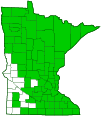ostrich fern
(Matteuccia struthiopteris var. pensylvanica)
Conservation • Wetland • Description • Habitat • Ecology • Use • Distribution • Taxonomy
Description |
||
Ostrich fern is a large, 12″ to 60″ tall, erect, perennial fern that rises from the above-ground crown of a vertical rhizome. The vertical rhizome produces numerous long-creeping, black, horizontal, underground runners (stolons) which root and give rise to new vertical rhizomes, producing new, genetically identical plants. Each plant produces two types of leaves (fronds), a dense spiral of several green, sterile fronds, with 1 or a few brown, fertile fronds in the center. The smaller fertile fronds are sometimes hidden by the larger sterile fronds. Less robust or unhealthy plants may not produce fertile fronds. The sterile frond is erect and arching. The leaf stem (stipe) is dark brown or black, stout, and 1¾″ to 18″ long. It is much shorter than the leafy portion (blade), about 1 ⁄10 to 1 ⁄5 as long. It is flattened at the base and becomes deeply grooved above the middle. It is sparsely covered with pale orangish-brown scales. It is deciduous and dies with the onset of winter. The blades of the sterile fronds are inversely lance-shaped to inversely egg-shaped in outline, 12″ to 50″ long, and 4¾″ to 10″ wide. They are widest above the middle, taper quickly to the tip, and taper very gradually to the base. The overall appearance is similar to an ostrich feather, hence the common name. The blades are pinnately divided into 20 to 60 pairs of leaflets (pinnae). The central axis of the blade (rachis) is covered with white hairs. The pinnae are alternate, spreading, and linear. The longest pinnae are 2½″ to 5¼″ long, becoming shorter as they approach the base. The lowest pinnae are much shorter, as little as ⅜″ long. The pinnae do not have a tuft of cinnamon-brown hairs at the base. They are deeply, pinnately lobed, with 20 to 40 lobes per side. The upper surface is medium green and hairless. The lower surface is paler green and hairless. The lobes of the pinnae are alternate to almost opposite, broadly oblong, squared off at the base, and rounded at the tip. The veins visible on the underside of each lobe extend straight to the margin and are not forked. The margins of the lobes are untoothed and unlobed. The fertile fronds are distinctive and unlike the sterile fronds. They appear on long stalks from July to October. When they appear they are 10″ to 25½″ long, and 1″ to 2½″ wide, shorter than the sterile fronds. There are 30 to 45 greenish pinnae per side. The pinnae are ⅜″ to 2″ long, linear, and shallowly lobed. The lobes of the pinnae are curled tightly around the sori forming small bead-like structures. When they mature the fertile fronds turn dark brown. They persist through the following winter and release their spores in March and April. |
||
Height |
||
12″ to 60″ |
||
Similar Species |
||
The above-ground, black, knob-like portion of the vertical rhizome, from which all fronds rise, the long-tapering blade, and the very short pinnae near the base of the blade are distinctive features of this plant. Cinnamon Fern (Osmundastrum cinnamomeum) does not rise from a black, knob-like crown. There is a small tuft of cinnamon brown hairs where the base of each pinna attaches to the rachis. The veins on the underside of the pinnae lobes are forked 1 to 3 times. Interrupted Fern (Claytosmunda claytoniana) does not produce separate fertile fronds, the fertile pinnae being produced in the middle of otherwise sterile leaves. The veins on the underside of the pinnae lobes are forked once. |
||
Habitat |
||
Swamps, floodplain forests, rich woods, streambanks. |
||
Ecology |
||
Sporulation |
||
March to April |
||
Pests and Diseases |
||
|
||
Use |
||
|
||
Distribution |
||||
|
Sources |
|||
| 3/24/2023 | ||||
Nativity |
||||
Native |
||||
Occurrence |
||||
Common |
||||
Taxonomy |
|||
| Kingdom | Plantae (Plants) | ||
| Division | Tracheophyta (Vascular Plants) | ||
| Subdivision | Polypodiophytina | ||
| Class | Polypodiopsida (ferns) | ||
| Subclass | Polypodiidae (leptosporangiate ferns) | ||
Order |
Polypodiales | ||
| Suborder | Aspleniinae (eupolypods II) | ||
Family |
Onocleaceae (sensitive ferns and allies) | ||
Genus |
Matteuccia (ostrich ferns) | ||
| Species | Matteuccia struthiopteris (ostrich fern) | ||
Ostrich fern is the only species in the genus Matteuccia. |
|||
Subordinate Taxa |
|||
|
|||
Synonyms |
|||
Matteuccia pensylvanica Matteuccia struthiopteris var. pubescens Onoclea struthiopteris Onoclea struthiopteris var. pensylvanica Pteretis nodulosa Pteretis pensylvanica |
|||
Common Names |
|||
fiddlehead fern garden fern hardy fern ostrich fern |
|||
Glossary
Frond
A large leaf with many divisions: in ferns, the compound leaf, including the stipe and the blade; in mosses, a closely and regularly branched stem resembling a fern leaf; in lichens, a stalkless, leaf-like extension.
Linear
Long, straight, and narrow, with more or less parallel sides, like a blade of grass.
Pinna
The primary division of a compound leaf or fern frond.
Pinnate
On a compound leaf, having the leaflets arranged on opposite sides of a common stalk. On a bryophyte, having branches evenly arranged on opposite sides of a stem.
Rachis
The main axis of a compound leaf, appearing as an extension of the leaf stalk; the main axis of an inflorescence.
Rhizome
A horizontal, usually underground stem. It serves as a reproductive structure, producing roots below and shoots above at the nodes.
Sorus
A compact cluster of spore-bearing cases or sacs (sporangia) on a fern.
Sporangium
A spore bearing structure, as of a fern or moss.
Stipe
A supporting stalk-like structure lacking vascular tissue: in fungi, the stalk supporting the mushroom cap; in ferns, the stalk connecting the blade to the rhizome; in flowering plants, the stalk connecting the flower’s ovary to the receptacle; in orchids; the band connecting the pollina with the viscidium.
Visitor Photos |
|||||
Share your photo of this plant. |
|||||
| This button not working for you? Simply email us at info@MinnesotaSeasons.com. Attach one or more photos and, if you like, a caption. |
|||||
|
|||||
MinnesotaSeasons.com Photos |
|||||
Plant |
|||||
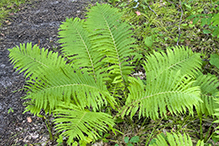 |
 |
||||
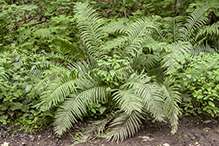 |
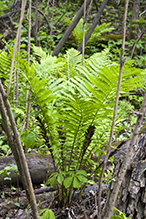 |
||||
Sterile Frond |
|||||
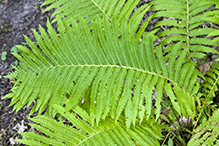 |
|||||
Fertile Frond |
|||||
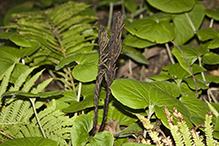 |
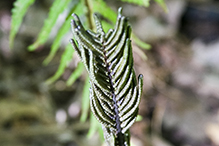 |
||||
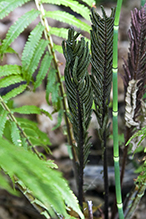 |
|||||
Pinnae |
|||||
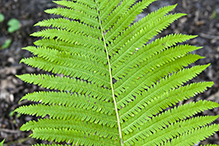 |
|||||

Slideshows |
||
| Matteuccia struthiopteris Susanne Wiik |
||

|
||
About
Strutseving |
||
| Ostrich Fern (Matteuccia struthiopteris) Andree Reno Sanborn |
||
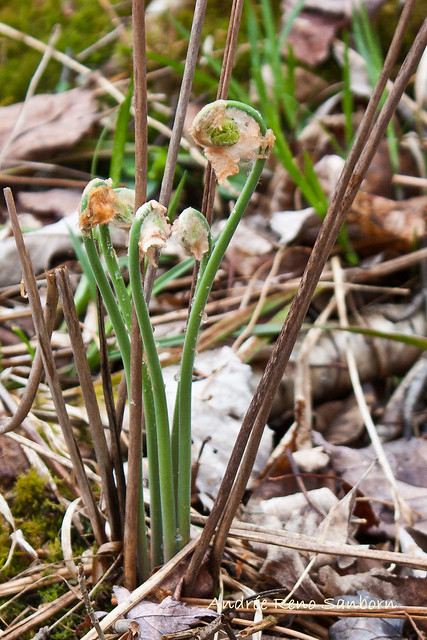
|
||

Visitor Videos |
|||
Share your video of this plant. |
|||
| This button not working for you? Simply email us at info@MinnesotaSeasons.com. Attach a video, a YouTube link, or a cloud storage link. |
|||
Other Videos |
|||
| F07 Matteuccia Struthyopteris Séquence 7-Fougères 1.m4v Jean Désorcy |
|||
About
Uploaded on Jan 10, 2010 La Matteuccie du printemps à l'automne. Ostrich Fern from spring to fall. Helecho Matteuccia Struthiopteris de la primavera hasta el otoño. |
|||
| Matteuccia struthiopteris wander van laar |
|||
About
Published on Jun 22, 2014 No description available. |
|||
| Ostrich Fern woodswoman783 |
|||
About
Uploaded on May 1, 2010 The fiddlehead of the ostrich fern is one of the best tasting of the wild edibles and one of the easiest ferns to ID. Fry it up in a little butter with wild leeks and/or morrel mushrooms and you have a wonderful side dish or an entire meal in the wild |
|||

Visitor Sightings |
|||||
Report a sighting of this plant. |
|||||
| This button not working for you? Simply email us at info@MinnesotaSeasons.com. Be sure to include a location. |
|||||
|
|||||
MinnesotaSeasons.com Sightings |
|||||
Charles A. Lindbergh State Park Forestville/Mystery Cave State Park John Peter Hoffman Spring Brook Valley WMA Lake Alexander Woods SNA, South Unit Minnesota Valley NWR, Chaska Unit Nerstrand Big Woods State Park Robert Ney Memorial Park Reserve Sand Prairie Wildlife Management and Environmental Education Area |
|||||

|
Created: Last Updated: © MinnesotaSeasons.com. All rights reserved. |
